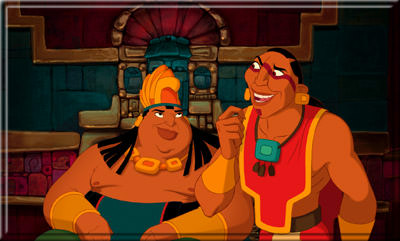 A response to my Indian Comics Irregular essay Road to El Dorado: Fool's Gold:
A response to my Indian Comics Irregular essay Road to El Dorado: Fool's Gold: A response to my Indian Comics Irregular essay Road to El Dorado: Fool's Gold:
A response to my Indian Comics Irregular essay Road to El Dorado: Fool's Gold:
>> One of the Aztec priests, who lasted through 5 kings, MURDERED 40,000 people (sacrifice) in ONE WEEKEND. <<
I'm curious where you got that statistic from. If it came from the Spanish, it's immediately suspect. More important, I'm guessing the European invaders murdered many more Indians than the Indians killed among themselves, and the movie doesn't reflect that. That's a central point of the critique.
>> They were fucking animals. <<
And the Christians who slaughtered millions in the name of God weren't? What about the Americans (of all denominations) who slaughtered Indians and blacks? We could go into the "barbarism" of almost every culture that's ever existed. If we're applying today's standards to the past, pretty much everyone fails them.
Anyway, I wouldn't call the Aztecs "animals." The key diference between murder and sacrifice is that the people, including the victims, believed in the concept of sacrificing people to the gods. As long as people buy into the system, and unwilling participants have the option to leave, one can consider the system itself valid. It may be alien to our way of thinking, but that doesn't make it invalid.
>> The Mexica movement? Is that the bunch of "any means necessary" gang-banging knuckleheads who want to kick everyone but Hispanics out of the entire Southwest? <<
I don't know who's behind the Mexica Movement. If they're gang-banging knuckleheads, they're smart enough to build a decent website, write prose without glaring mistakes, and get an op-ed piece published in the LA Times. Just taking a wild stab here, but I'm guessing at least some of them are college-educated professionals.
Judging by their website, they want "independence" from the Euro-American power structure. Which is okay by me, since I'm not crazy about the power structure either. As I recall, they define "independence" nebulously and aren't calling for reparations or the return of specific lands.
Their primary means seems to be education, which is why Olin Tezcatlipoca wrote his article and why I echoed his sentiments. Educating people about Native cultures and history is a cause I support wholeheartedly. As for whatever they mean by independence, they're welcome to try for it, but I think the effort is misguided, if not a waste of time. They'd be better off working to change the existing system than abandoning it for some impossible dream.
There. I hope that mollifies your concerns. Can't we all get along? <g>
Addendum
I didn't want to argue with this correspondent, who is (was?) a friend. But if you're feeling holier-than-an-Aztec, consider this. In America today we "murder," "sacrifice," or simply kill:
We're also content to let 10 million children around the world die each year of disease and malnutrition when we could easily save them with a few dollars of aid per child. And we continue to do nothing whenever genocide or large-scale massacres occur in places such as Rwanda, Chechnya, or East Timor. Letting people die is very much akin to sacrificing them to maintain our level of comfort and prosperity. If you're really concerned about human life, you save these people, regardless of the cost.
If you feel these cases are different from the Aztecs' sacrifice of human victims, go ahead and explain how. I repeat that people in the Aztec culture wanted to be there, even knowing they could be chosen to be sacrificed. You could argue that convicted felons knew the penalty for their crimes, but neither animals, fetuses, starving children, nor genocide victims chose to be sacrficed by us.
In short, if the Aztecs were animals, I guess we're all animals. Besides, the correspondent's attitude ignores Mesoamerican accomplishments in art, architecture, agriculture, astronomy, arithmetic, and other subjects not beginning with "A." To call Mesoamericans "animals" when they achieved a remarkable civilizaton is the worst possible kind of stereotyping.
Incidentally, this correspondent's assumption that anyone who demands the return of "Hispanic" land must be a "gang-banging knucklehead" seems blatantly racist. Sorry, friend, but we did steal Mexican land, through what the world would now condemn as an illegal and immoral war. How does noting that fact make one anything close to a criminal or rotten person?
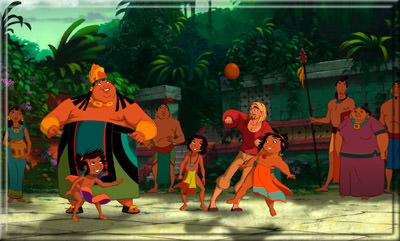
The debate continues....
>> Rob, you really don't know Meso-American history. <<
True, I have "only" two books on the Maya and two on the Aztec among my 100 or so works on Native America. Fortunately, I can supplement this storehouse of information with the Web. For instance:
Why Learn This History Stuff Anyway?
In an attempt to remain objective in this brief essay, I will not overlook accounts of human sacrifice by the Aztecs. Indeed these atrocities were committed by the Aztecs on some captured male prisoners. The degree to which these operations were carried out is debated by historians. Some estimates suggest that the Aztecs sacrificed up to 20,000 captives a year. Stannard reports that some modern scholars view the number of 20,000 to be greatly exaggerated as a result of conquering interest. Whatever the case may be, Stannard quotes Pedro de Cieza de Leon, a conquistador in 1553, as saying: "These and other things are the testimony the Spaniards raise against these Indians. . . endeavoring by these things we tell of them to hide our own shortcomings and justify the ill treatment they have suffered at our hands. . . I am not saying that they did not make sacrifices. . . but it was not as it was told." Stannard also notes that: ". . . in the siege of Tenochtitlan the invading Spaniards killed twice that many people in a single day including (unlike Aztec sacrifice) enormous numbers of innocent women, children, and the aged."
This doesn't excuse the Aztec atrocities, of course. I don't know how many of the Aztecs' subjects shared their belief in ritual sacrifice, but I think many did. For those who didn't, there's no justification for imposing a deadly system on them.
For more information on how our culture propagandizes against indigenous people, visit the Newsweek Propaganda Analysis. An excellent (if long) article I just found.
>> Tlapalel was the high priest who presided over the repeated ritual murder of hundreds of thousands of his own people, including children. Their own records show it. <<
I haven't heard of Tlapalel. Neither have any of my favorite search engines: Yahoo, AltaVista, AskJeeves, Google, and Northern Lights. That may be why this fact remains obscure to my knowledge. <g>
Correspondent misses the points
But let's not get too far off track. The issue I raised is how The Road to El Dorado portrays Mesoamericans in general. Several key points:
1) The Aztec empire reigned for only a few decades. It wasn't representative of thousands of years of Mesoamerican history.
2) The Mesoamericans in El Dorado weren't Aztecs but rather a mishmash of Mesoamerican cultures. Equating all Mesoamericans with Aztecs is patently false.
3) The Spaniards eventually killed more Mesoamericans than all the Aztec sacrifices combined. If numbers are the guideline, the two sides were not morally equivalent.
>> If you have Real Player, go to the Fox News site and click on the video about the Mechista movement (might be the same as Mexica, I don't know). <<
After a brief search on the Web, I believe you're talking about MEChA. A Mechista is one of their members. That group is different from the Mexica Movement.
The so-called American Patrol puts a negative spin on MEChA at The MEChA Sickness. On the other hand, a cursory glance at the Web shows MEChA organizations at major colleges and universities. Unless Loyola Marymount, San Jose State, San Diego State, etc. are conspiring with MEChA to start a race war and "liberate Aztlán," I'm not particularly worried. (I can confirm that MEChA existed at Occidental College without harming or threatening anyone.)
More on MEChA and the Mexica Movement from correspondent Al Carroll (2/18/03):
MEChA is just your basic Latino college students group. There are chapters at every school I've attended, UT at San Antonio, Purdue, and ASU. They did "radical" things like collect Toys For Tots, canned goods, and lobby the university for more funding for Mexican-American Studies. Mildly reformist at best. My guess would be the "news" people found a few students within one chapter they could quote out of context.
The Mexica movement is more along the lines of Mexican kids with Indian ancestry trying to recover their Indian heritage. Some of what they say is over romanticized or vague, but they did win the respect of at least a few Natives I know of. Mikey Zamora is one of the Mexica people, and he works on the mascot issue. The Native rapper Litefoot also had some links to the Mexica movement on his website last time I looked at it a few years ago.
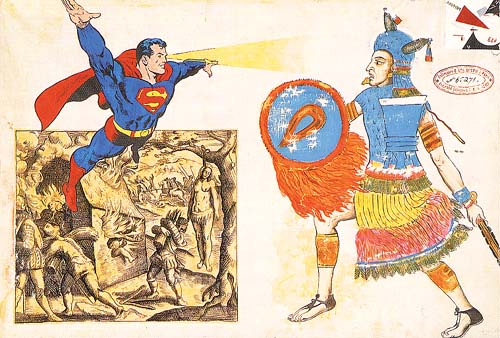
And from "Raza Isn't Racist" by Gustavo Arellano in the LA Times, 6/15/06:
As both a member of the invading army and a proud son of Mexican-hating Orange County, I can testify that, without a doubt, MEChA is harmless.
Sure, the organization's founding documents, the Plan de Santa Barbara and the Plan Espiritual de Aztlán, call for a Chicano homeland. But few members take these hilariously dated relics of the 1960s seriously, if they even bother to read them. Little of the modern-day MEChA remains separatist, other than the occasional Che-spouting junior and a few cute mestizas with Aztec names like Citlali who sport Frida ponytails, black-frame glasses and Chuck Taylor high-tops.
MEChA's primary objectives are not secessionist but educational (get as many Latino high schoolers into the universities as possible and help them stay there) and cultural. For many Mexican American students, MEChA is their family by proxy, a support network for those of us who were the first in our families to graduate from high school, let alone college.
>> If they got their way, they'd murder YOUR ass and not think twice about it. You're white and you're evil and wrong as far as they're concerned. <<
I read through the Mexica Movement site and didn't see anything about violence there. Besides, anything said by either group is pure talk as far as I'm concerned. When I see a real threat and not just hopeful words, I'll worry about it.
>> I find a great number of writers to be de facto liberals and wide-eyed communists, often because they're simply ill-educated. Give George Orwell's "Animal Farm" a serious read. <<
I've read it, along with 1984 and my voluminous material on Native Americans. I've also read the newspaper cover to cover every day (excluding vacations) for the last 30 years, as well as countless other sources of news. As an information junkie, I doubt you'll find many people more up on the issues than me.
>> A lot of killing goes on in the name of religion. If you're pissed off about it, pay more attention to modern-day killings of women in Iran under the Ayatollah and protest about that. There's a good article about it in the latest Reader's Digest. <<
How do you know how much attention I've paid to the killings in Iran already? Reader's Digest isn't exactly known as an unbiased source. And two wrongs don't make a right, so I don't see how this justifies the stereotyping of Mesoamericans.
Anyway, my theme is the need for a multicultural perspective, which encompasses the need to recognize good and bad in all cultures. If I raise awareness on that issue, people will pay more attention to problems everywhere, including Iran, Afghanistan, Sudan, Zimbabwe, Sierra Leone, and every other Third World country we can name. Or so the theory goes.
Bottom line is that I reported the Mexica's Movement boycott of El Dorado. I didn't endorse their boycott, much less any of their other positions. Feel free to debate the issues, but try to avoid painting me as a terrorist dupe, please. <g>
Your pal,
Rob
Evidence against the Aztecs
Evidence May Back Human Sacrifice Claims
By Mark Stevenson
Associated Press
posted: 23 January 2005
06:40 pm ET
MEXICO CITY (AP) — It has long been a matter of contention: Was the Aztec and Mayan practice of human sacrifice as widespread and horrifying as the history books say? Or did the Spanish conquerors overstate it to make the Indians look primitive? In recent years archaeologists have been uncovering mounting physical evidence that corroborates the Spanish accounts in substance, if not number.
Using high-tech forensic tools, archaeologists are proving that pre-Hispanic sacrifices often involved children and a broad array of intentionally brutal killing methods.
For decades, many researchers believed Spanish accounts from the 16th and 17th centuries were biased to denigrate Indian cultures, others argued that sacrifices were largely confined to captured warriors, while still others conceded the Aztecs were bloody, but believed the Maya were less so.
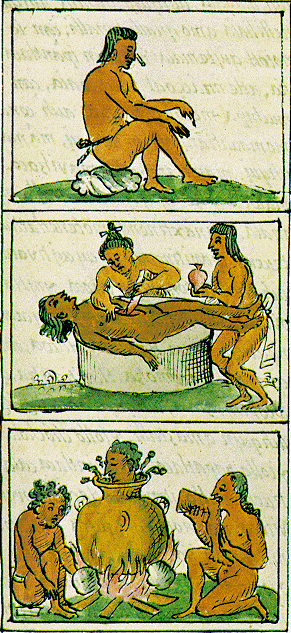
"We now have the physical evidence to corroborate the written and pictorial record," said archaeologist Leonardo Lopez Lujan. He said, "some 'pro-Indian' currents had always denied this had happened. They said the texts must be lying."
The Spaniards probably did exaggerate the sheer numbers of victims to justify a supposedly righteous war against idolatry, said David Carrasco, a Harvard Divinity School expert on Meso-American religion.
But there is no longer as much doubt about the nature of the killings. Indian pictorial texts known as "codices," as well as Spanish accounts from the time, quote Indians as describing multiple forms of human sacrifice.
Victims had their hearts cut out or were decapitated, shot full of arrows, clawed, sliced to death, stoned, crushed, skinned, buried alive or tossed from the tops of temples.
Children were said to be frequent victims, in part because they were considered pure and unspoiled.
"Many people said, 'We can't trust these codices because the Spaniards were describing all these horrible things,' which in the long run we are confirming," said Carmen Pijoan, a forensic anthropologist who found some of the first direct evidence of cannibalism in a pre-Aztec culture over a decade ago: bones with butcher-like cut marks.
In December, at an excavation in an Aztec-era community in Ecatepec, just north of Mexico City, archaeologist Nadia Velez Saldana described finding evidence of human sacrifice associated with the god of death.
"The sacrifice involved burning or partially burning victims," Velez Saldana said. "We found a burial pit with the skeletal remains of four children who were partially burned, and the remains of four other children that were completely carbonized."
While the remains don't show whether the victims were burned alive, there are depictions of people — apparently alive — being held down as they were burned.
The dig turned up other clues to support descriptions of sacrifices in the Magliabecchi codex, a pictorial account painted between 1600 and 1650 that includes human body parts stuffed into cooking dishes, and people sitting around eating, as the god of death looks on.
"We have found cooking dishes just like that," said archaeologist Luis Manuel Gamboa. "And, next to some full skeletons, we found some incomplete, segmented human bones." However, researchers don't know whether those remains were cannibalized.
In 2002, government archaeologist Juan Alberto Roman Berrelleza announced the results of forensic testing on the bones of 42 children, mostly boys around age 6, sacrificed at Mexico City's Templo Mayor, the Aztec's main religious site, during a drought.
All shared one feature: serious cavities, abscesses or bone infections painful enough to make them cry.
"It was considered a good omen if they cried a lot at the time of sacrifice," which was probably done by slitting their throats, Roman Berrelleza said.
The Maya, whose culture peaked farther east about 400 years before the Aztecs founded Mexico City in 1325, had a similar taste for sacrifice, Harvard University anthropologist David Stuart wrote in a 2003 article.
In the late 19th and early 20th century, "The first researchers tried to make a distinction between the 'peaceful' Maya and the 'brutal' cultures of central Mexico," Stuart wrote. "They even tried to say human sacrifice was rare among the Maya."
But in carvings and mural paintings, he said, "we have now found more and greater similarities between the Aztecs and Mayas," including a Maya ceremony in which a grotesquely costumed priest is shown pulling the entrails from a bound and apparently living sacrificial victim.
Some Spanish-era texts have yet to be corroborated with physical remains. They describe Aztec priests sacrificing children and adults by sealing them in caves or drowning them. But the assumption now is that the texts appear trustworthy, said Lopez Lujan, who also works at the Templo Mayor site.
For Lopez Lujan, confirmation has come in the form of advanced chemical tests on the stucco floors of Aztec temples, which were found to have been soaked with iron, albumen and genetic material consistent with human blood.
"It's now a question of quantity," said Lopez Lujan, who thinks the Spaniards — and Indian picture-book scribes working under their control — exaggerated the number of sacrifice victims, claiming in one case that 80,400 people were sacrificed at a temple inauguration in 1487.
"We're not finding anywhere near that ... even if we added some zeros," Lopez Lujan said.
Researchers have largely discarded the old theory that sacrifice and cannibalism were motivated by a protein shortage in the Aztec diet, though some still believe it may have been a method of population control.
Pre-Hispanic cultures believed the world would end if the sacrifices were not performed. Sacrificial victims, meanwhile, were often treated as gods themselves before being killed.
"It is really very difficult for us to conceive," Pijoan said of the sacrifices. "It was almost an honor for them."
From the LA Times:
SCIENCE FILE
Aztecs Tortured, Ate Spaniards, Bones Show
Evidence of capture and rituals is unearthed at a site near Mexico City.
From Reuters
August 26, 2006
CALPULALPAN, Mexico — Skeletons found at an archeological site show that Aztecs captured, sacrificed and partially ate several hundred people traveling with invading Spanish forces in 1520.
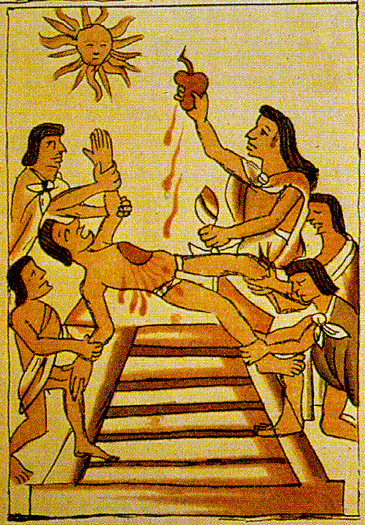
The condition of skulls and bones from the Tecuaque site east of Mexico City offers evidence that about 550 victims had their hearts ripped out by Aztec priests in ritual offerings, and were dismembered or had their bones boiled or scraped clean, experts say.
The findings support accounts of Aztecs capturing and killing a caravan led by Spanish conquistadors in revenge for the murder of Cacamatzin, king of the Aztec city of Texcoco. Experts said the discovery proved that some Aztecs did resist the conquistadors led by Hernan Cortes before they attacked the Aztec capital, Tenochtitlan, now Mexico City.
History books say many indigenous Mexicans initially welcomed the white-skinned horsemen, thinking they were returning gods, but turned against them once they tried to take over the Aztec seat of power in a conflict that ended in 1521.
"This is the first place that has so much evidence there was resistance to the conquest," said archeologist Enrique Martinez, director of the dig here. "It shows it wasn't all submission."
The prisoners were kept in cages for months while Aztec priests selected a few each day, cut out their hearts and offered them up to various Aztec gods, Martinez said.
"It was a continuous sacrifice over six months. While the prisoners were listening to their companions being sacrificed, the next ones were being selected," Martinez said, standing in his lab amid boxes of bones, some of young children.
The priests and town elders sometimes ate their victims' hearts or cooked flesh from their arms and legs, Martinez said. Knife cuts and even teeth marks on the bones show which ones had meat stripped off to be eaten, he said.
In Aztec times, the site was called Zultepec, a town of white-stucco temples and homes where 5,000 people grew maize and beans. Upon hearing of the massacre, Cortes renamed the town Tecuaque — "where people were eaten" in the indigenous Nahuatl language — and sent an army to wipe out its people.
When they heard the Spanish were coming, the Zultepec Aztecs threw their victims' possessions down wells, unwittingly preserving buttons and jewelry for archeologists.
"They hid all the evidence," Martinez said. "Thanks to that act, we have been allowed to discover a chapter we were unaware of in the conquest of Mexico."
Rob's comment
One, Tecuaque is an isolated incident. There's no evidence of an ongoing pattern. Two, it occurred in retaliation for the murder of a king. This was probably even more heinous than the murder of a monarch would've been to Europeans. Three, the Aztecs offered the hearts to their gods, which means they were doing it out of sincere conviction, not depraved inhumanity.
Let's also note the larger point: that there's no evidence of large-scale sacrifices on the order of tens of thousands. To reiterate: "We're not finding anywhere near that ... even if we added some zeros," Lopez Lujan said. So now scientists are explicitly repudiating the unsubstantiated claims of the correspondent who started this debate.
Aztecs in the Stereotype of the Month contest
Aztec animals in Chihuahua
Aztec religion = dinosaur worship
Aztecs game cover shows scantily-clad woman wielding axes
Indians practicing cannibalism and torture dominated America
Aztecs = reality of pre-Columbian Indians, not Pocahontas
"Natives were content with a...simple, animallike existence"
Indians' killing "parallels that of the Spanish Inquisition"
Europeans wanted only to civilize cannibalistic "thugs"
Columnist: Aztec "dining habits" involved eating hearts
Church historians don't believe God chose Juan Diego
Beer company suggests Atlanteans built Wisc. mounds
Website seeks to disprove the "magic" of ethnic weapons
More Aztecs in the media
Aztec religion = dinosaur worship
Aztec curse in Pirates
Aztecs rule in Gate of Worlds
More Aztec information
Human sacrifice in Aztec culture
Related links
Indians as cannibals
Indiana Jones and the stereotypes of doom
Savage Indians
The search for Aztlán
Native vs. non-Native Americans: a summary
Readers respond
An anthropologist claimed "cannibalism only existed symbolically, in a book a few years back."
"I'm not sure if [murdering 40,000 people in one weekend is] actually a stereotype—it happened."
[E]very man woman & child would've had to eat at least 55 pounds of 'meat' in 48-72 hours."
"[T]hat's 13.888 victims a minute. Or to put it differently, it took 3.2 seconds per victim."
|
. . . |

|
All material © copyright its original owners, except where noted.
Original text and pictures © copyright 2007 by Robert Schmidt.
Copyrighted material is posted under the Fair Use provision of the Copyright Act,
which allows copying for nonprofit educational uses including criticism and commentary.
Comments sent to the publisher become the property of Blue Corn Comics
and may be used in other postings without permission.